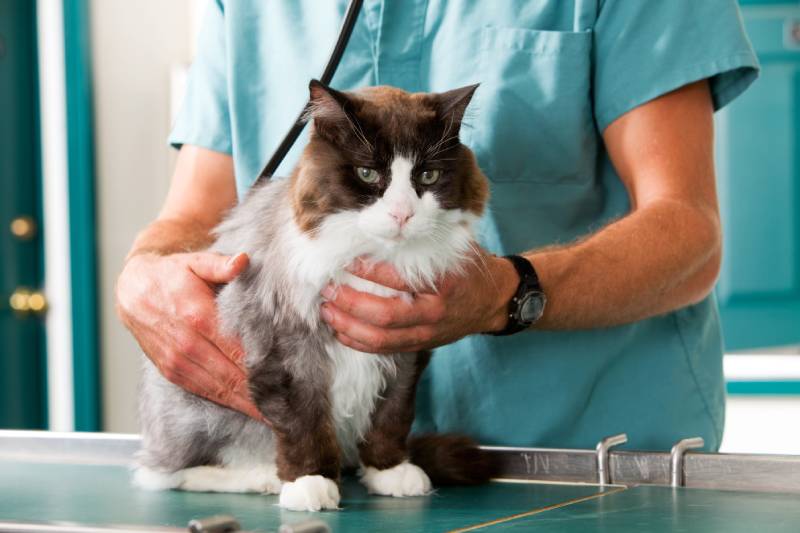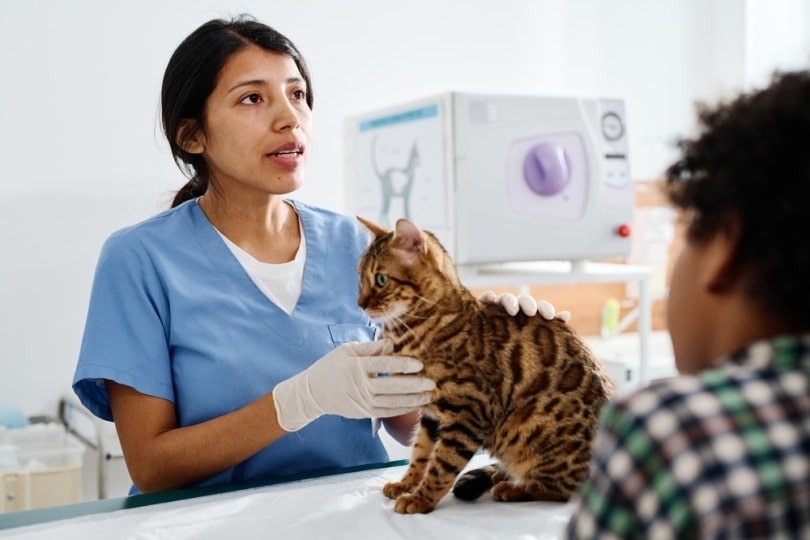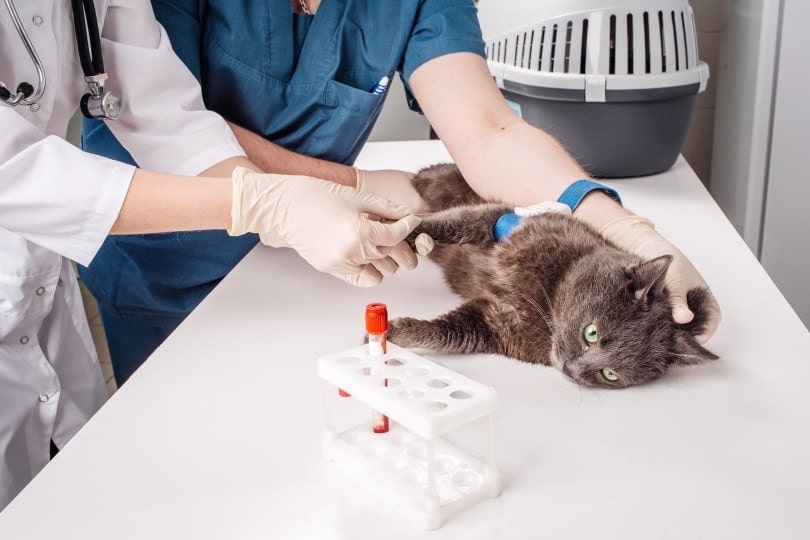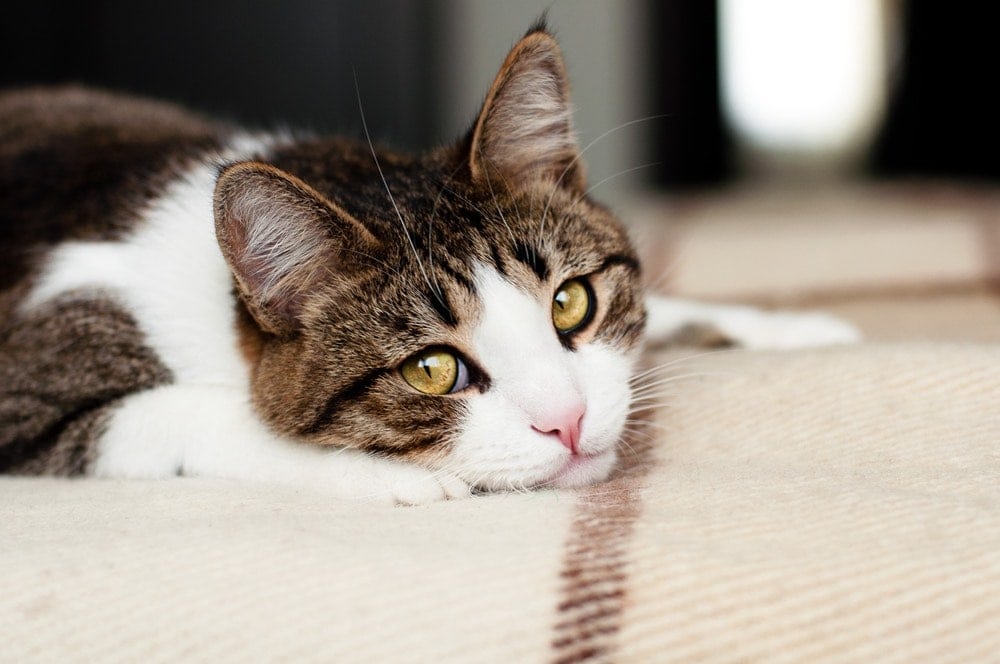How to Increase Red Blood Cells in Cats (Vet Answer)

Updated on

Click to Skip Ahead
Erythrocytes, also called red blood cells, are circulating blood cells that play a crucial role in tissue oxygenation. They are constantly being replaced, but if they decrease faster than new ones can be produced, the total number of red blood cells will be lower than normal, preventing normal circulation and tissue oxygenation. This condition is called anemia.
The number of your cat’s red cells can be determined at a complete blood count (CBC), which is a blood test used to analyze the different populations of blood cells. It’s done to evaluate your cat’s overall health and detect a wide range of conditions.
If your cat has a low red blood cell count, you can increase it by giving them iron supplements (but not before talking to your vet) or feeding them iron-rich foods like lean meat, fish, and eggs.
In this article, you will learn why red blood cells are important, what causes a low red blood cell count in a cat, and what you can do in certain cases to help increase it.
Why Are Red Blood Cells Important?
Red blood cells play an important role in your cat’s health, as they carry fresh oxygen throughout the body. The protein inside red blood cells that ensures the transportation of oxygen is called hemoglobin. These cells also have the role of removing carbon dioxide from the body, transporting it to the lungs to be eliminated with exhaled air.
Analysis of the number of red blood cells in the body may be necessary for screening or to help diagnose or monitor diseases that affect the values of these cells.
- Anemia
- Infections
- Lung diseases
- Kidney diseases
- Cancer
- Dehydration
- Autoimmune diseases
- Feline leukemia virus
- Feline immunodeficiency virus
- Intoxications
An increase or decrease in the number of red blood cells must be interpreted by the vet in accordance with other blood tests, such as hemoglobin, hematocrit, blood biochemistry, or rapid tests.

What Are the Causes of Low Red Blood Cells in Cats?
- Acute blood loss
- Chronic low-grade blood loss
- Interference with the formation or release of erythropoietin
- Cessation of production or survival of red blood cells
- Destruction of red blood cells
Red blood cells are produced by the bone marrow and have a limited lifetime. In healthy cats, the number of this type of cell remains within a constant range over time. If there are certain pathologies, the number of red blood cells can increase or decrease beyond the physiological reference ranges. In cats, the reference range for the number of red blood cells in healthy individuals is 6.9–10.1×106/µL. If your cat’s number of red blood cells is too low (below the reference range), it means they have anemia.
- Regenerative — This is when the bone marrow can still produce new red blood cells but fewer in number. This type of anemia can be caused by external or internal blood loss (due to tumors, parasites, ulcers, accidents, toxins, or infections).
- Non-regenerative — This is when the bone marrow no longer produces new red blood cells. This type of anemia occurs in bone marrow disorders, chronic liver diseases, kidney diseases, poor diet, etc.
What Are the Clinical Signs of Anemia in Cats?
- Sudden weight loss
- Lack of appetite (your cat refuses food)
- Lack of activity (your cat shows extreme fatigue, sleeps excessively, and stops playing)
- Pale mucous membranes (your cat’s gums look pale pink or a whitish color)
- Increased heart rate
- Excessive thirst
- Weakness
- Lethargy
- Increased breathing rate
- Increased respiratory effort
- Collapse (in severe cases)
If not treated quickly, anemia can lead to your cat’s death. Therefore, if you notice these clinical signs, take your cat to the vet immediately.
How Is Anemia in Cats Diagnosed and Treated?
To diagnose anemia, your veterinarian will draw a blood sample from your cat to perform a CBC. This type of blood test will show your vet how many red blood cells, hemoglobin, white blood cells, and platelets your cat has. CBC can also reveal what kind of anemia your cat has (regenerative or non-regenerative).
Once the type of anemia is diagnosed, the vet may recommend additional tests (depending on your cat’s clinical signs) to identify the cause that led to the decrease in the number of red blood cells.
Depending on the severity of the anemia and the primary condition, the veterinarian may also recommend a blood transfusion, medication, a change in diet, surgery (in case of internal bleeding), or other treatments.

How to Increase Red Blood Cells in Cats
The number of red blood cells can be increased by blood transfusion (in case of severe anemia), specialized medications to stimulate erythropoietin, iron, B vitamins, and folic acid supplements or by regularly ingesting iron-rich foods. Regarding iron supplements, always talk to your veterinarian because large doses can lead to toxicity. Iron-rich foods are the best options when you want to increase your cat’s red blood cell count organically.
- Lean meat (turkey, chicken, and beef)
- Liver (contains six times more iron than muscle meat but should be offered in moderation and occasionally, as its high vitamin A and copper content may lead to health issues when offered in excess)
- Fish (always cooked and without bones)
- Eggs (cooked well and only in moderation)
In any case, it is recommended to talk to your veterinarian before adding new foods to your cat’s diet.
- Vaccinate your cat according to the vaccination schedule.
- Deworm your cat regularly.
- Treat your cat regularly against fleas, as recommended by your vet.
- Feed them a complete and balanced diet.
- Take your cat to the vet for regular check-ups.
Conclusion
A decrease in the number of red blood cells can become problematic and lead to anemia. Signs of anemia in cats include pale gums, lethargy, decreased appetite, weight loss, extreme fatigue, and rapid heart rate and breathing. Your cat’s red blood cell count can be seen on a CBC, which is a routine blood test. If your cat has a low red blood cell count, it can be increased by blood transfusion (in severe situations), specialized medications, supplements, or iron-rich foods. Whether you choose supplements or foods rich in iron, talk to your veterinarian first. Iron in high concentrations can become toxic to cats.
Featured Image Credit: Tyler Olson, Shutterstock












